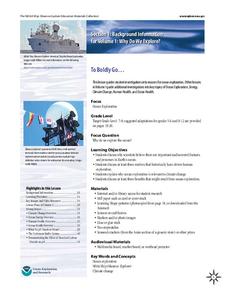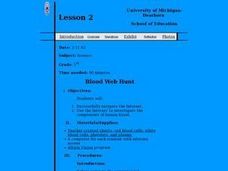Curated OER
Seeing is Believing - Or Is It?
Here is a great science instructional activity. It extends the concept of vision into the area of optical illusions, perspective, and tessellation. This well-designed plan has tons of great activities, utilizes interesting video, and...
Curated OER
In the Eyes of the Beholder
Students identify parts of the eye and their functions through participating in a cow's eye dissection lab. They investigate vision problems and diseases, focusing on their causes, and how abnormal vision can be aided with technology.
Curated OER
Applied Science - Science and Math Lab
Students explore the senses. In this Applied Science lesson, students investigate the items in "feely" boxes with their hands, both touching the items and shaking the boxes to hear the sound the items make. Students also smell and taste...
NOAA
To Boldly Go...
When we think of ocean exploration, many of us have visions of sunken pirate ships full of treasure or mysterious creatures of the deep. What really motivates deep-sea investigation? The first in a series of diverse six-part lessons...
Curated OER
Superhumans & Bionics; Electronic Eyes
Students examine the anatomy of the eye and the physiology of vision. Students participate in a modeling activity to demonstrate the difference between a healthy eye and an eye affected by macular degeneration. Students match part of...
Curated OER
For Your Eyes Only
Students complete several activities in a unit related to the eye. In this eye lesson plan, students work in groups to research information about the human eye and create a multimedia presentation. They research anatomy of the eye, how...
Curated OER
The Eye; Structure and Function
Students research the structure and function of the eye. In this anatomy lesson, students write a report about the eye and draw an illustration. They research a particular animal's eye then present their findings to the class without...
Curated OER
How Evolution Works
Students work in groups to investigate and present genetic variation, adaptation, and sexual selection as it relates to evolution. In this evolution lesson plan, students watch a video discuss how the human eye could evolve due to...
Curated OER
Feelin' Buggy
Students discuss five senses, compare and contrast human and insect senses, use adjectives to describe things they touch, smell, and see, and write stories in first person describing what it would be like to be size of insect.
Howard Hughes Medical Institute
Explore Your Inner Animals
Human bodies prove evolution thanks to our genes, bones, and more. Learning about specific body parts and how they evolved from other species helps individuals better understand the transition species that helped us become who we are today.
Curated OER
Exploring Learned and Innate Behavior
Students explore the differences between learned and innate behavior among humans and monkeys. They complete an assignment and read articles about two studies, which used similar test methods to show that infants and monkeys share an...
Nuffield Foundation
Investigating How We See Colour
Can you eyes be fooled into seeing colors that aren't actually there? Budding scientists view a presentation that addresses this topic. They explore how their eyes interpret color through the retinas and messages sent to the brain. They...
BioEd Online
The Skeleton
Don't be chicken to try a lesson plan that compares the anatomy of birds to humans. Read the background information so you don't have to wing it when it comes to the anatomy of a chicken. Prepare cooked chicken bones by soaking them in a...
Perkins School for the Blind
Learning to Identify Sounds Made by the Body
Sneeze, snap, tap, and whistle; Did I do that? Explore the parts and sounds of the human body with your learners with visual impairments. First you'll name the parts of the body, make a sound with each part, and then have the class guess...
American Museum of Natural History
What's This? Reproduction
Attracting the right mate is as important for humans as any other species. An interesting lesson teaches individuals about several strategies that animals and plants have adapted to attract their mates. From colorful nests to powerful...
Curated OER
You Won't Believe Your Eyes!
Students gain a basic understanding of the sense of sight. They watch a video on sight, then engage in some vocabulary games, and perform some simple experiments which focus on the basics of sight.
Curated OER
Growing Eyeballs
Students investigate vision and the anatomy of the human eye. They complete a Webquest, watch a video about the structure of the eye, take an online quiz, answer discussion questions, and read newspaper articles about activities that...
Curated OER
Comparing Three Animal Brains
In this animal brain activity, students view images of a human brain, toad brain, and shark brain along with descriptions of each. They answer 3 short answer questions.
Curated OER
Blood Components Web Hunt
Fifth graders watch a short video on blood and complete worksheets on the components of blood. They navigate the Internet to investigate the components of human blood. They complete worksheets with a partner and exchange sheets among...
Curated OER
What is the Anatomy of the Visual System?
Students research the structures and functions of the eye. In small groups they dissect a model of the human eye, identify structures of the eye, and describe the functions of the photoreceptors.
Curated OER
Lunar Field Trip
Young scholars take a virtual tour on Google Moon of what human life would be like on the moon. In this moon lesson plan, students also compose web diagrams, make charts, make a time line, investigate problems, and more.
Curated OER
Primate Evolution
In this primate evolution worksheet, high schoolers use a diagram showing different primate adaptations to complete 3 short answer questions comparing human traits and primate traits.
Curated OER
Sound for Sight
Students study echolocation and understand how dolphins use it to locate prey, escape predators, and navigate their environment. They view a video, "In the Wild-Dolphins with Robin Williams" and see first hand how dolphins communicate. ...
Curated OER
Twisted Vision
Students explain polarization vision and why some animals have it while others do not. They examine the reasons why it would be helpful for marine organisms to have polarized light.

























